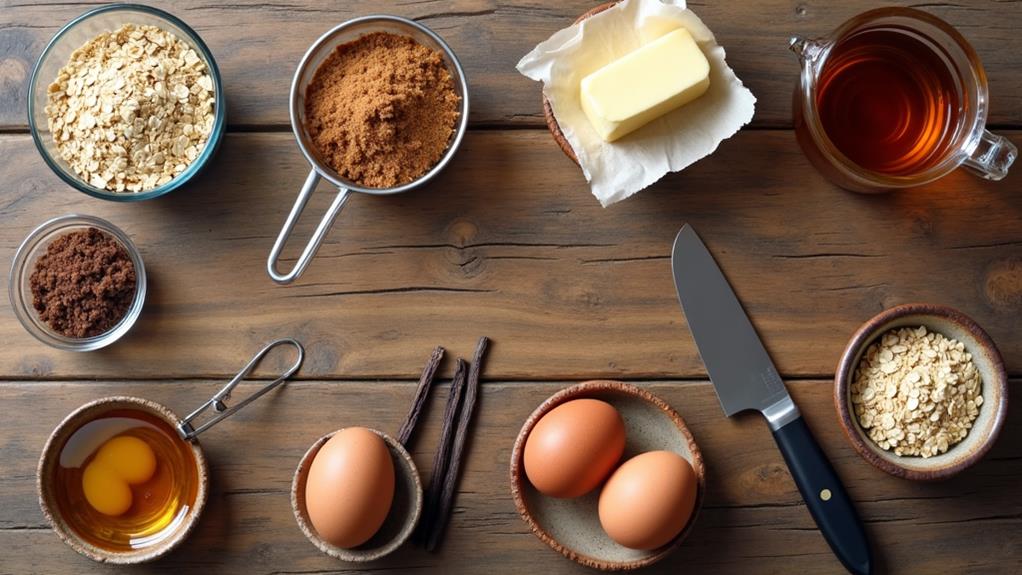You might not know that maple syrup, a key ingredient in maple oatmeal cookies, has been used for centuries by Indigenous peoples long before it became a staple in American cuisine. When you combine this rich syrup with wholesome oats, you create a cookie that's not only delicious but also steeped in history. Understanding the balance of flavors and the science behind cookie texture can elevate your baking game. So, what's the secret to achieving that perfect chewiness while maximizing flavor?
History
Oatmeal cookies have a rich history that dates back to the early 19th century, when oats were a staple in many households, especially in Scotland and England.
These humble grains were easy to grow and packed with nutrients, making them a perfect ingredient for baking. By the late 1800s, the combination of oats and sweeteners like maple syrup gained popularity in North America, thanks to advancements in sugar production.
The first recorded oatmeal cookie recipe appeared in the 1896 edition of the Boston Cooking-School Cookbook by Fannie Farmer.
This was a game changer, as it helped introduce these delightful cookies into American kitchens. Fast forward to the 1930s, and oatmeal cookies became a nutritious snack option during the Great Depression, offering a delicious way to stretch ingredients and feed families.
Today, maple oatmeal cookies have evolved, incorporating regional flavors and local ingredients, especially in the Northeastern United States.
They're not just a nostalgic treat; they're a beloved part of contemporary baking. So, the next time you savor a warm oatmeal cookie, remember its journey—from a simple staple to a modern favorite!
Recipe

Maple Oatmeal Cookies Recipe
Indulging in warm, chewy cookies is a delightful experience, and Maple Oatmeal Cookies are no exception. Combining the wholesome goodness of oats with the rich sweetness of brown sugar and maple syrup, these cookies offer a comforting treat that's perfect for any occasion.
With hints of cinnamon and vanilla, each bite is bursting with flavor, making them a sure hit among cookie lovers. To guarantee the best texture and flavor, it's essential to chill the cookie dough before baking. This step allows the ingredients to meld together, creating a cookie that's soft and chewy on the inside with a perfectly golden edge.
Whether enjoyed fresh out of the oven or saved for later, these cookies are a delightful addition to your dessert repertoire.
Ingredients:
- 1 cup rolled oats
- 1 cup all-purpose flour
- 1/2 cup brown sugar, packed
- 1/2 cup maple syrup
- 1/2 cup unsalted butter, softened
- 1 large egg
- 1 teaspoon vanilla extract
- 1 teaspoon ground cinnamon
- 1/2 teaspoon baking soda
- 1/4 teaspoon salt
Instructions:
In a large mixing bowl, cream together the softened butter and brown sugar until light and fluffy. Add the maple syrup, egg, and vanilla extract, mixing until well combined.
In a separate bowl, whisk together the rolled oats, flour, cinnamon, baking soda, and salt. Gradually incorporate the dry ingredients into the wet mixture, stirring until just combined.
Once the dough is ready, cover the bowl with plastic wrap and refrigerate for at least 3 hours or overnight to chill.
When ready to bake, preheat your oven to 350°F (180°C). Scoop tablespoons of dough onto a lined baking sheet, spacing them about 2 inches apart. Bake for approximately 16 minutes, or until the edges are golden but the centers remain tender.
Allow the cookies to cool on the baking sheet for a few minutes before transferring them to a wire rack to cool completely.
Extra Tips:
For the best results, confirm that your dough is well-chilled before baking, as this will help the cookies maintain their shape and achieve the perfect chewy texture.
Store any baked cookies in a sealed container at room temperature for up to a week for ideal freshness. Additionally, you can freeze any remaining cookie dough for future baking sessions—just thaw it overnight in the refrigerator before baking.
If you're looking to explore similar treats, consider trying oatmeal raisin cookies or experimenting with variations such as adding chocolate chips or nuts to the Maple Oatmeal Cookies for an extra crunch.
These variations offer delightful twists while maintaining the core flavors of the original recipe.
Final Notes
When it comes to enjoying your Maple Oatmeal Cookies, remember that the key to their deliciousness lies in the details. These cookies aren't just any treat; they're soft and chewy, thanks to the proper hydration of oats and a little underbaking.
To really elevate that maple flavor, use darker grade maple syrup and brown sugar. Don't rush the process—chill your dough for at least three hours so the oats absorb moisture, which makes a world of difference in texture and taste.
When you're ready to bake, line your baking sheet with parchment to prevent sticking. After baking, let those cookies cool on a cooling rack to maintain their perfect softness. If you've got a sweet tooth, consider adding dark chocolate chips for an extra layer of flavor.
To keep your maple oatmeal cookies fresh, store them in an airtight container at room temperature for up to a week. If you can resist, they freeze beautifully for up to three months.
Just remember, for the best taste and texture, enjoy them within the first few days. Trust us, you'll want to savor every bite!
